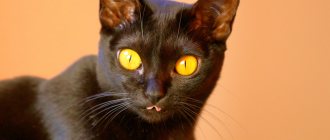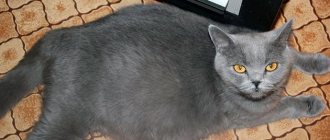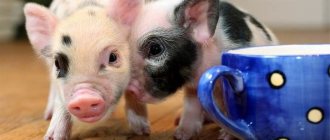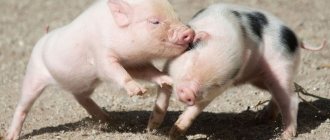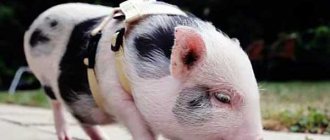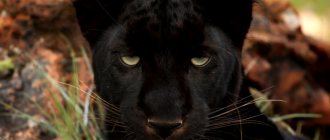The black Bombay cat has nothing to do with the ancient Indian city. She looks like a mini-panther, and owes her appearance to the crossing of two breeds - the Burmese and the American Shorthair. For superstitious people, this cat personifies something terrible, since its color from the tip of its nose to the pads on its paws is jet black. It is worth mentioning separately about the coat of the Bombay cat - its smoothness, shine and density, as well as its impenetrable ink color, are more reminiscent of patent leather than just short hair.
Americans even call representatives of the Bombay breed “shoe polish beauties with eyes like shiny copper coins.” Our compatriots, seeing this cat, will most likely exclaim in admiration: “Bagheera!”
Origin story
The Bombay cat has nothing to do with either Bombay or India - such a paradox. The breed owes its appearance to a very stubborn and persistent American breeder named Nikki Horner, who lives in the USA. It was she who came up with the idea: to breed an animal that would be as close in appearance as possible to the Indian leopard.
It was Bagheera, a flexible, dexterous and stunningly beautiful animal, who was for Nikki the symbol of the embodiment of masculinity and feline grace. Why not give people the opportunity to have a mini-copy of it in their own home? - she thought.
Work began in 1953 and continued for several years. Nikki picked up the first pair - a female Burmese, winner of many competitions with sable skin, and a male - a brutal American shorthair cat. The first litter was not very successful, but the stubborn woman did not think of stopping. By the mid-60s, small replicas of mini-panthers created a real sensation.
In 1976, the breed was recognized by The Cat Fanciers' Association, and almost immediately became the winner of both national and regional competitions. In 1979, the breed was recognized by the TICA organization.
By this time, Nikki had already begun to slowly move away from breeding cats. However, her work did not stop: breeders Suzanne and Herb Zwecker began working on the breed. Their pet, the black cat Luv It Black, became the ancestor of many representatives of the hybrid. But some organizations (for example, FIFe) still do not classify the Bombay cat as a recognized breed.
Today there are only a few dozen individuals in the world. It is allowed to cross American short-haired cats with Burmese cats of a certain color. However, the breeding process is not an easy task. It often happens that there is only one coal-black toddler in a litter, while the rest have a dominant gene that gives the coat a sable color. The Burmese breed is a leading breed as a partner. “Americans” are used less often: in this case, the physique deteriorates.
Disqualifying signs:
- Tail with kinks;
- Colored spots on the body;
- Extreme bend of the nose;
- Overshot or undershot;
- Excessive number of fingers;
- Paw pads and nose are a different (not black) color.
Standards
Bombay cats are distinguished by their rare quality and grace. The usual height at the withers is 20-30 cm, weight is from 3 to 5.5 kg. Females are lighter than males.
| Standard | Description |
| Scull | Round, without noticeable corners or protrusions. |
| Muzzle | Wide, with a firm, strong chin and powerful jaws. The bite is pincer-shaped, which is considered correct according to the standard. The “stop” on the nose is pronounced, the tip is slightly rounded. |
| Ears | Medium in size, with rounded tips. |
| Eyes | Round, large, widely spaced. The colors of the iris range from pale gold to dark amber. There are also green-eyed individuals. |
| Torso | Compact, long, with good muscles and strong bones. The chest is wide, the hips and shoulders are strong. Both the hind and forelimbs are long, slender, and muscular. The paws are round, small, with elastic pads. Bombay cats have a swaying gait and smooth movements. |
| Tail | Dense, not very long, tapering towards the tip. |
| Wool | Short, thin, fits tightly to the body, as if covered with varnish. There is no undercoat. |
General information
Today, there are two types of Bombay cats: American and British. The American was obtained by crossing a Burmese and an American Shorthair. British - by mixing the blood of wild Burmese cats with domestic ones. The main difference between these lines is eye color. According to the standard, American women have bronze-colored eyes (the color of a penny), while British women have green eyes.
In general, representatives of the breed are distinguished by their unusual beauty and gracefulness - with characteristic smooth, black, as if on fire, fur. The animals are hardy and strong, like real panthers, despite their average size.
Colors
According to the standard, the coat color should be black: completely from the tail to the ears. Kittens are allowed to have small spots, but they should disappear with age. In addition to the coat, the paw pads, nose, and all the fingers should be jet black.
The photo shows a Bombay cat during a hunt.
Expert opinion
Dusheba Vera Ivanovna
In 2010, she graduated from the Moscow State Academy of Veterinary Medicine named after K.I. Scriabin with honors, specializing in veterinary medicine. I regularly attend veterinary conferences, congresses, and webinars.
A kitten “for the soul”, i.e. with certain defects that do not allow him to take part in exhibition events, and without a pedigree, cost from 10,000 rubles. Sleek show-class babies cost much more: from 50,000 and above.
When planning to buy a kitten, contact official nurseries or breeders whose reputation is not in question. The baby can be reserved in advance, but picked up no earlier than 12-16 weeks after he was born. The baby should be sociable and playful and eat well. Be sure to observe the behavior of his parents: a lot will become clear to you. And don't forget to pick up all the documents!
Activity
The Bombay cat is a very active, nimble and self-confident animal. It loves to get attention, poke its nose in and have fun in every possible way. Therefore, the pet must be provided with a large number of toys. Particular attention should be paid to devices for the development of intelligence and physical activity (labyrinths, cat trees, etc.).
Mini panthers love to spend time with their owner. Therefore, they get great joy from playing together and learning tricks. Of course, such a pet will not be able to bring slippers in its teeth, but smaller things are easy.
Bombay cats also have a well-developed hunting instinct, despite their aristocratic appearance and grace. These amazingly active and dexterous animals are excellent at catching mice when necessary. Some individuals even eat them with pleasure.
Character and behavior
The Bombay cat is a very balanced and peaceful creature. From her ancestors she inherited such traits as restraint, calmness, non-conflict and contact. All family members are her best friends. She does not single out a leader for herself, but on the contrary, she herself strives to take the dominant place in the house, but she does this very gently and unobtrusively.
She is quite a talkative person: her voice is an opportunity to convey her desires to others and share her problems. Females are more “chatty”, and their purring is much more melodic and gentle than that of males.
They get along well both in an apartment and in a private house. They don’t need a lot of space, but their own play corner is desirable. Buy a small play complex with pipes and shelves of different heights - this will be quite enough. In the warm season, it is advisable to take the animal for a walk. If you teach your pet to use a leash from early childhood, you will not have problems in the future.
Name the cat who always wanted to live together
BasilioLeopold
Bombay cats quickly establish contact with other cats and dogs, sometimes even becoming truly friends. But birds and small rodents are prey for them, so don’t be surprised why your cat sits for hours near a cage with a parrot, not taking its eyes off it.
Cats of this breed are lenient towards children: they can tolerate pranks for quite a long time, but at a certain moment they can crack their paws.
Bombays always run to meet guests, but at first they treat them very, very warily: after sniffing their hands, they won’t allow themselves more. And if a person has bad intentions, they will immediately feel it and will behave even more carefully and may show aggression: start hissing at the guest and hiding from him in a secluded corner.
Young Bombay residents are very inquisitive and love to stick their satin nose into all the nooks and crannies of their home, but with age they become more sedate, choosing an observation post somewhere on the windowsill or the back of the sofa, and observing those around them from there.
Bombay Breed Health
global $ads_google;
//data-ad-slot=”2475549904″ $ads_google = empty($ads_google) ? false : true; ?> if ($ads_google == false) {?> $ads_google = true; ?> } ?> Since the Bombay cat was bred artificially by crossing, there are some diseases at the gene level, such as hypertrophic cardiomyopathy. The disease is detected only during examination by specialists based on a number of signs.
In addition to heart disease, Bombay residents sometimes suffer from skull deformities, obesity, gum and eye diseases.
Despite good health, an attentive owner will not allow the cat to be in a draft and will get all vaccinations on time. Vaccination can protect your beloved purr from many cat diseases. The lifespan of a Bombay cat depends on care and is about 15-20 years.
If you do not spay or neuter the animal by the time of puberty, then after one or two heats the cat can be bred with a male. Mating is possible only with completely healthy individuals, it is better when this happens on the 2-4th day of estrus.
Pregnancy lasts 65 days and is almost always infertile.
Childbirth should not frighten the owner, since the cat is sensitive to attention during this period and relies on humans.
Buy a Bombay kitten
If you want to buy a Bombay cat kitten, then you should not immediately show interest in amateurs offering to make a purchase on Avito and other websites. It is very easy to fall for the bait of scammers and pay a considerable amount for a simple black baby that has nothing to do with this breed. A cat with a pedigree can be found in nurseries that offer only healthy cats. Since they are fully cared for, vaccinated, breeders vouch for the quality of their work, so the cost of Bombays is high.
For a young representative of the Bombay breed you will have to pay not a small price, but a substantial one: about 60,000 rubles.
Nicknames for Bombays
In order not to call the little Bombay by an inappropriate name, they first try to get to know his character at least a little. Affectionate purrs, interesting hooligans, funny and curious hustlers - each kitten needs a special nickname.
The ideal name often contains hissing sounds and is obviously liked by the young, active animal. For a boy, you can choose a nickname that is more serious and even brutal, while for girls, sweet-sounding, gentle names are suitable.
If you have difficulty choosing, you can refer to the table of names.
| Girl | Boy | ||
| Palmira Pussy Geneva Sarbon Perseya Brad Motya Susanna Anna Soot Troy Vanilka Janine Neko Abi | Nancy Koda Elika Iksa Prima Rusya Judy Olympiada Camellia Alisa Anet Belka Ulita Naranya Lolita | Apricot Lel Kiryusha Peter Yasha Partos Tom Pukhlik Mario Typhoon Batyr Andy Grimm Altai Quasimodo | Zord Mart Lex Irwin Kantor Jack Cyclops Tyson Chizhik Solomon Pirate Kuzmich Arnold Bayun Bai |
Care instructions
Caring for Bombays is not at all difficult.
Wool
The smooth, short fur does not require endless brushing and never gets into tangles, so it is enough to comb it a little once a week with a rubber brush and remove any remaining fur with wet hands.
Bathing
These cats have a neutral attitude towards bathing: they are not fans, but they also do not cause a tragedy because they were put in a bowl of water.
However, frequent bathing will only harm both the skin and coat. Once every 4-5 months is enough, and use only special shampoo: without irritating components.
Ears, eyes, teeth
The ears, teeth and eyes also require attention. The teeth are cleaned with cat paste and a silicone soft brush (or an ordinary baby brush, the bristles of which are trimmed a little), the eyes are wiped with fresh chamomile infusion, tea leaves or chlorhexidine. Ears - with a cotton swab dipped in boiled water.
If you notice the appearance of dark plaque, tartar, or purulent discharge from the eyes or ears, take the animal to the veterinarian. The disease is easier to cope with at the initial stage.
These cats prefer heat more than cold, so try to protect them from drafts and low temperatures. Buy your cat a nice, cozy house with a roof and a soft pillow inside, and put it in a dry and warm place (but not next to a central heating radiator or heater). This will be a place of rest and relaxation for him.
The photo shows Bombay kittens
Conditions of detention
It is necessary to provide your pet with a large number of toys, otherwise he will play with everything that he thinks is comfortable.
You should also provide a secluded sleeping place, because sometimes he still needs privacy.
A daytime bed should be set up in a place where the pet will be able to see everyone and everything, and also sleep comfortably while lounging. Bombays love warmth and can easily catch cold from drafts.
Catering
Bombays love to eat and lick their bowls until they shine. But too much food will turn from an elegant and graceful animal into a clumsy bun, suffering from shortness of breath, palpitations, diabetes, or worse. Therefore, remember the following:
- The cat must not be overfed! Adult animals (over six months old) eat 2 times a day: morning and evening. An exception can be made for lactating and pregnant females, sick or elderly animals. Teenagers 4-6 months eat 3-4 times, babies – 5-6.
- The animal should be switched to a new food gradually, and not suddenly change the diet. Apart from indigestion, this will not bring any benefit.
- You cannot mix natural food and ready-made food: choose one.
- Your cat should have separate bowls for water and food. It is advisable to wash the dishes after each meal so that they do not stagnate and become saturated with an unpleasant odor.
- Be sure to clean drinking water from harmful impurities and chlorine. A regular faucet filter will help with this. Or you can leave the liquid in a jar without a lid for 8-12 hours in a dark place.
Natural products
The following natural products are allowed:
- Meat. Only low-fat varieties: rabbit, turkey, veal, beef. The meat is pre-frozen, and before feeding it is thawed and doused with boiling water to destroy possible parasites. They feed the meat every day, cutting it into pieces 1-2 cm long. Fat layers, bones, and skin are removed. The exception is chicken necks: they are ground into minced meat along with cartilage.
- Fish. Salmon families: chum salmon, pink salmon, salmon, river trout. Or lean (if the cat is on a diet): blue whiting, cod, hake. All sharp parts, bones and fins must first be removed. It is also undesirable to give heads and milk. The fish is boiled for at least 20 minutes in unsalted water and given once a week. More often it is impossible - excess fish leads to the development of urolithiasis.
- By-products. This is an additional source of minerals and vitamins. Liver, hearts, ventricles - boiled or raw.
- Dairy products. Low-fat cottage cheese, natural yogurt without dyes and other additives, kefir, fermented baked milk, yogurt, low-fat sour cream.
- Eggs. Chicken ones are boiled and only the yolk is given to the cat (the protein gives the cat diarrhea), quail ones are fed whole.
- Porridge. Buckwheat, rice, oatmeal, barley. Porridge can be included in the diet when the kitten is 1.5 months old: first they are cooked in milk, and then in vegetable or meat broth. You can feed porridge every other day in the proportion of one part porridge to 3 parts meat.
- Vegetables. No more than 10% of the daily food intake. Zucchini, carrots, broccoli, asparagus, green beans, celery, beets. You can’t give them raw ones – the cat might choke! The exception is cucumbers and melons. They perfectly quench thirst. The hard skin can be removed.
It is prohibited to give:
- Pork and pork by-products (contains histamines), goose, duck and lamb (poorly digested), fresh liver and raw lung (causes diarrhea and vomiting), minced meat from the store (it often contains skin and fat);
- Corn, pea, millet porridge, semolina (it is acceptable to feed babies liquid semolina porridge with milk), instant porridge;
- Avocado, garlic, onions, grapes, raisins (and dried fruits). Potatoes cause constipation, so you should be careful with them;
- Sweet, smoked, salty, flour, baked goods;
- Dog food;
- Human vitamins;
- Tea, coffee, cocoa, whole cow's milk, mineral and sparkling water, juices, compotes.
Recommended food
Among industrial feeds, holistic and super-premium class feeds are considered the best. These are Fitmin Purity, Go Natural, Arden Grange. The rest - food from the economy and premium groups - are made from meat waste (rather than pure meat), contain chemical preservatives, dyes and flavor enhancers, which, naturally, will not benefit the cat.
Below are the recommended holistic and super-premium foods. Links with the names of the food are clickable, on them you can, within our website, get acquainted with the descriptions of the food and read reviews from the owners of the Bombay cat breed.
| Holistic | Holistic | Super premium |
| Canagan | Gather | Bozita |
Features of feeding
Adherents of natural nutrition for Bombay cats create their own diet. But veterinarians insist that the menu be based on meat products. They can be supplemented with cereals, fruits, vegetables and other ingredients that are allowed for cats. You can feed Bombay cats with ready-made dry food. But it should only be of high quality, with a high content of meat products, essential vitamins and minerals. You need to feed your pet approximately at the rate recommended by the food manufacturer. Typically, an adult healthy animal is given food twice a day.
It is worth noting that Bombays are unusually voracious cats that love to eat their fill. Stealing food and stealing food from the table is a common occurrence for this breed. However, it is important to monitor the amount of food taken so that the animal does not overeat. Otherwise, this risks obesity, which negatively affects health. If the cat has gained a lot of weight, you will have to go to the veterinarian so that he can select a diet.
Diseases
Bombay cats cannot be called sissies, sneezing from every draft, but they do have health problems.
Together with their genes, they were given such a serious pathology as hypertrophic cardiomyopathy - enlargement of the heart muscle. At the beginning, the disease is asymptomatic, but the older the cat gets, the more it begins to suffer from shortness of breath and fatigue, sleeps a lot, and refuses to play or run. Unfortunately, it is impossible to cure this disease, but monitoring a veterinarian and following his recommendations will help prolong the life of your pet.
The following pathology is called “Burmese craniofacial defect”. Kittens still in the womb experience deformation of the skull, so severe that newborn babies are subjected to immediate euthanasia.
The pathology is caused by an autosomal recessive gene, which, unfortunately, cannot be predicted and cannot be destroyed. A special note about this is made in the pedigree.
A pronounced “stop” on the nose and a curvature of the internal septum lead to problems with nasal breathing. The nostrils often become clogged with mucus, and the eyes “stream.” The only way to help your cat is by regular washing.
Expert opinion
Dusheba Vera Ivanovna
In 2010, she graduated from the Moscow State Academy of Veterinary Medicine named after K.I. Scriabin with honors, specializing in veterinary medicine. I regularly attend veterinary conferences, congresses, and webinars.
Follow your vaccination schedule strictly. And it doesn’t matter whether you take your cat out for a walk on the grass or whether she sits at home all the time. The causative agents of many diseases (panleukopenia, calcivirosis) can be brought home on street shoes or clothing.
Bombay cats begin to ask for a partner as early as 6-9 months, but you should not follow their lead: the animals’ bodies at this age are not yet formed. 2 years is the optimal age for the first mating for both males and females. If you do not plan to breed, take the animal for sterilization (castration).
How to choose a kitten
Buy a kitten that has reached 13-16 weeks of age.
Description of a healthy animal:
- playful, inquisitive character;
- a fearless, non-aggressive, trusting attitude towards visitors;
- excellent appetite;
- clear eyes, clean eyes and ears;
- harmonious physique, unbroken tail;
- clean body without signs of skin and parasitic diseases;
- shiny, evenly colored coat.
The breeder provides the buyer with a veterinary passport with vaccination records.
Breed cost
The Bombay cat is expensive. The price of up to $500 for a kitten with a pedigree is cause for concern. It is difficult for a non-professional to distinguish a Bombay from an ordinary cat. An ordinary yard kitten does not have a tarry-brilliant color or a bright copper iris.
How much Bombay purebred kittens cost depends on the breed class:
- a sterilized pet (companion) will cost $500;
- breed (for breeding) – $800-1000 ;
- a Bombay kitten of the show category (exhibition) will cost 1200-1500 dollars.
Nurseries
Finding kennels with a high reputation is problematic, because the Bombay breed is rare.
Reputable cat breeders:
- in Moscow – Murmurcat;
- St. Petersburg – Mission;
- Kovrov – Golden Claw;
- Minsk – Jera;
- in Novosibirsk there is a nursery of Bombay cats Black Label.
